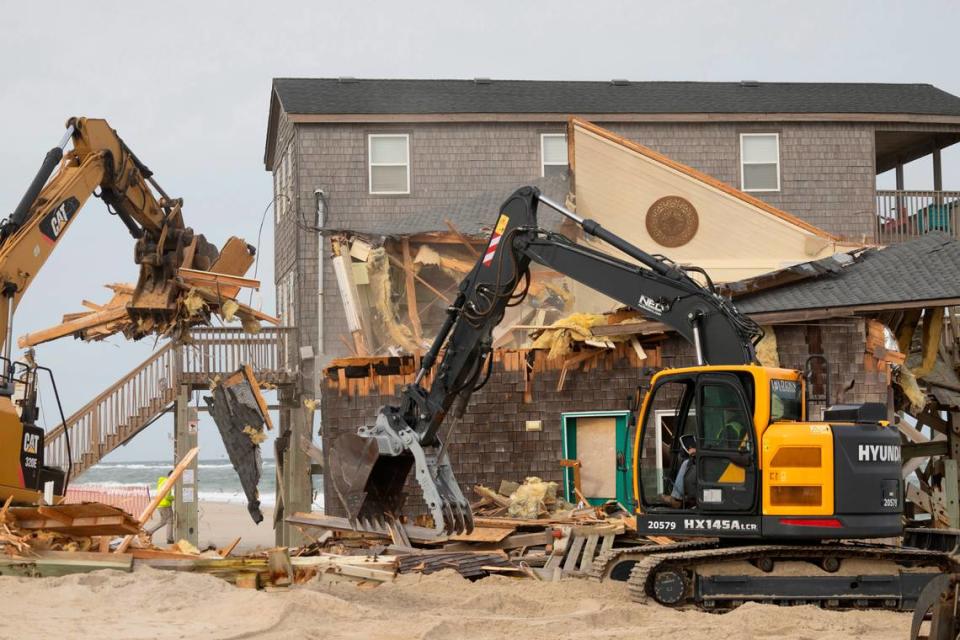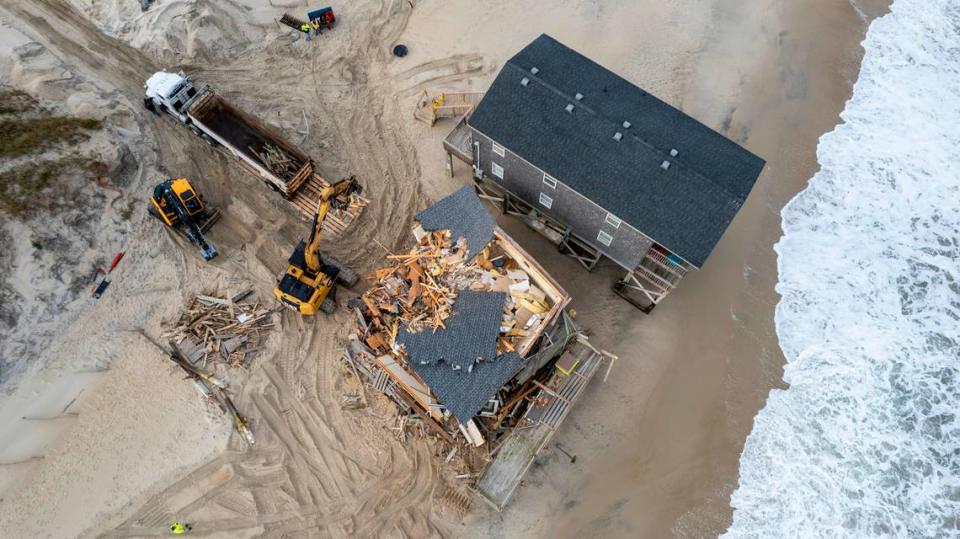National Park Service begins demolishing erosion-threatened Rodanthe beach homes
After the sound of chainsaws cutting through stilts rang across the oceanfront Wednesday, the brief silence was conspicuous.
Then the beeping started, and an excavator pulled a chain attached to a house sitting on the beach. A front-end loader on the home’s side pushed its claw against a piling, urging the home away from the encroaching tide.
Within 90 seconds, the house shifted off of its stilts and faltered toward the dune line, landing with a thud.
David Hallac, superintendent of the Cape Hatteras National Seashore, turned around and said, “Nicely done.”
The Park Service bought the house and another standing next to it earlier this year. The homes are being demolished as part of a pilot program, an effort to prove that the federal government can buy erosion-threatened properties and remove them before Mother Nature does
The Cape Hatteras National Seashore has been struggling with home collapses in Rodanthe in recent years, with five toppling into the surf since 2020.
When the homes collapse, they are an expensive headache to clean up.

If they’re not dealt with quickly, tides and currents can drag nails and insulation and shingles miles down the coastline. Septic tanks associated with the homes can split open, spilling their contents over what is supposed to be a pristine public shoreline.
“A lot of the debris gets caught in that longshore current and before you know it you can have debris by the end of the day 10 miles away,” Hallac said.
Hallac estimated that each cleanup of an unplanned house collapse costs tens of thousands of dollars. That can be borne by homeowners, but it’s often been Park Service staff mobilizing to collect bits and pieces of houses to keep them from breaking down and washing up elsewhere along the shore.
In an effort to avoid some of these problems, Hallac and his staff are experimenting with buying homes that are most threatened before they can collapse.
Hallac views homes threatened by erosion as everybody’s problem — not just the homeowner’s. The Park Service, for example, has to grapple with the environmental implications of any debris or pollution stemming from a collapse.
“The homeowners didn’t place their houses here. It happens because of erosion. In some cases, it happens rather suddenly so from our perspective we’re in the position of trying to work with the homeowners and our partners to try to find solutions,” Hallac said.
Hallac said a 1980 map showed the northernmost home purchased by the Park Service sitting safely inland, tucked behind a vegetated dune.
Judy Guzy has owned a home on East Point Drive in Rodanthe for nearly 50 years. She’s watched as homes have been built and as homes have been moved to escape the rising ocean. Wednesday, she held a decades-old photo that showed the dune line extending well past one of the two homes purchased by the Park Service.
Guzy said she was shaken when she saw the construction equipment start operating.
“This has been a part of my life. These homes have always been here,” Guzy said. “But I’m happy that they’re not going to be in the water creating the mess.”
She remains confident that the erosion won’t reach her home a few houses behind the dune line.
“I probably won’t be here by the time the ocean comes to my house but I’ll enjoy it until then,” she said.
The East Beacon Road homes were sitting in the middle of the beach strand earlier this summer, stuck between the dune that is supposed to protect property and the high tide line. A glance at the Dare County property map for both properties shows that more than half of the lots supposed to be associated with the homes were below the high tide line.
To buy the homes, the Park Service turned to the Land and Water Conservation Fund, a pot of money funded by the leases of public lands for oil and gas exploration.
Geologically, the Outer Banks are defined by a slow march westward. Tides nibble sand from the oceanfront and then carry particles westward, grain by grain. It’s difficult — and many experts argue impossible — to square that with owning property on the oceanfront.
The northern end of Rodanthe is particularly prone to erosion. A study prepared for Dare County earlier this year found that the shoreline there is eroding at a rate of 10 feet per year.

While the Outer Banks has a history of structures falling into the ocean, Hallac said that historically has happened during large storms. The problems faced by Rodanthe represent a shift.
“The last four houses that fell in, they fell in on days like today,” Hallac said, referencing the overcast — but not stormy — weather. “Those are more hitting this tip point where this chronic erosion puts these houses in extremely precarious positions.”
Further compounding the problem for homeowners in the area, the new Jug Handle Bridge opened earlier this year, lifting a flood-prone section of NC 12 and sending it into the Pamlico Sound.
Without the need to protect that crucial lifeline, the Park Service won’t allow more beach nourishment in northern Rodanthe. The Park Service is wary of nourishment on its shores, unless it is done to protect critical infrastructure like Highway 12, the north-south road that ties the Outer Banks together.
Future nourishment of the beach there is possible, Hallac said, but the Park Service would need to be convinced that infrastructure — not private property — was at risk.
By 3 p.m., the home was largely demolished. The excavator had ripped off its southern half and, around 2:50, pulled on and crunched the western wall until it was fully toppled.
Within days or weeks, the Park Service will tear down the neighboring home, at 23298 East Beacon Road. As Wednesday’s demolition took place, there was still beach furniture on its porch.
This story was produced with financial support from the Hartfield Foundation and 1Earth Fund, in partnership with Journalism Funding Partners, as part of an independent journalism fellowship program. The N&O maintains full editorial control of the work.


